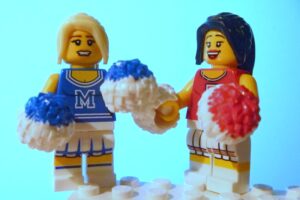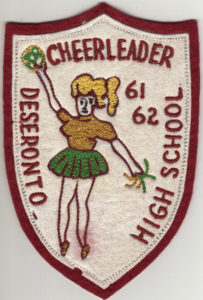The Supreme Court of the United States heard arguments in April in the Mahanoy Area School District v. B.L. case (audio is here).
The Mahanoy case is about a 14-year-old high school cheerleader, who failed to make the cheerleading varsity teams of her school and vented her frustration on social media in no uncertain terms. She posted on Snapchat a photo of her and a friend both “flipping the bird” with the text, “fuck school fuck softball fuck cheer fuck everything” superimposed on the photo. The snap post was made on a weekend, the picture had not been taken on school’s premises, and did not mention or name the high school.
The cheerleading squad to which the teenager belonged had the following for policy:
Please have respect for your school, coaches, teachers, and other cheerleaders and teams. Remember, you are representing your school when at games, fundraisers, and other events. Good sportsmanship will be enforced, this includes foul language and inappropriate gestures…. There will be no toleration of any negative information regarding cheerleading, cheerleaders, or coaches placed on the internet.
The teenager was suspended from the squad for a year because she had been “disrespectful” when posting the Snap message.
She sued the school district claiming a violation of her First Amendment rights. The United States District Court for the Middle District of Pennsylvania granted summary judgment in her favor, ruling that the school had violated her First Amendment rights. The Third Circuit agreed and affirmed, holding that Tinker does not apply to off-campus speech.
The School District then filed a certiorari petition to the Supreme Court, which was granted. This is an important case as the Court will decide whether a school can discipline students for any off-campus speech, including speech on social media.

The Tinker 1969 case: should it apply today for social media speech?
The question presented to the Supreme Court is whether its “Tinker v. Des Moines Independent Community School District case, which holds that public school officials may regulate speech that would materially and substantially disrupt the work and discipline of the school, applies to student speech that occurs off campus.”
Indeed, the Court held in is 1969 Tinker case that “[s]chool officials do not possess absolute authority over their students.” For the Court, students or teachers did not “shed their constitutional rights to freedom of speech or expression at the schoolhouse gate.”
However, Tinker provided a narrow exception that student conduct, “in class or out of it, which for any reason — whether it stems from time, place, or type of behavior — materially disrupts classwork or involves substantial disorder or invasion of the rights of others” is not protected by the First Amendment.
In Tinker, petitioners were teenagers who had planned to wear black armbands at school to protest the Vietnam war. The school had then adopted a policy banning wearing armbands at school. Petitioners had nevertheless worn armbands and had been suspended. The students who gave their name to this famous case, Mary Beth Tinker and John Tinker, filed an amici curiae brief in the Mahanoy case in support of Respondents (the teenager and her parents).
Law professors Bambauer, Bhagwat and Volokh’s Amici Curiae Brief
Law professors Bambauer, Bhagwat and Volokh filed an amici curiae brief in support of Respondents, explaining that they were concerned that extending Tinker “to all off-campus student speech… expected to reach campus… would empower schools to punish students for expressing unpopular or controversial viewpoints.”
They argued that, while student speech outside school activities should generally be fully protected by the First Amendment, the “schoolhouse gate” is no longer only physical, but is also virtual. This argument is acutely understood in 2021 after more than a year where students were taught online, attending classes from home because of the pandemic.
As all students‘s online speech is expected to reach campus, expanding Tinker to online speech “would be an enormous expansion of schools’ power to censor the speech of their students.” They propose to apply Tinker to student speech outside the school only in certain cases, such as when students say “cruel personal things to or about each other, especially online,” that is, bullying or harassment. Disruptive speech in a school-sponsored forum could be disciplined as well.
Arguments of the Petitioners
During the arguments, Petitioners’ counsel mentioned that for state law or policies in all fifty states, including statutory law in twenty-six states , “the standard for bullying is severe, persistent harassment that interferes, actually prevents that child from getting an education.” For instance, New York law defines “harassment” and “bullying” as “creation of a hostile environment by conduct or by threats, intimidation or abuse, including cyberbullying,” that would, inter alia, “unreasonably and substantially interfere with a student’s educational performance, opportunities or benefits, or mental, emotional or physical well-being” or “reasonably cause or would reasonably be expected to cause a student to fear for his or her physical safety.”
Petitioners argue schools can regulate off campus speech if it is directed at the school and the audience is the school.
During the oral argument, Justice Thomas asked Petitioners’ counsel whether the place where a student posts a social media post, at school or at home, does make a difference for applying Tinker. Counsel stated that it does not make a difference.
Justice Breyer said that the teenager’s speech, while inelegant, had not caused a material and substantial disruption, and quipped that, if swearing off campus did cause such disruption, “every school in the country would be doing nothing but punishing.”
Justice Alito said that he had no idea of the meaning of speech “targeting the school.” Justice Sotomayor asked Petitioner’s attorney whether a student could be punished for cursing at her home or on the way to school (no was the answer). Justice Sotomayor added that she had been told by her clerks “among certain populations, a certain large percentage of the population, how much you curse is a badge of honor,” asking how the line would be drawn if such language would target the school.
Arguments of the Respondents
Counsel for Respondents argued “expanding Tinker would transform a limited exception into a 24/7 rule that would upend the First Amendment’s bedrock principle and would require students to effectively carry the schoolhouse on their backs in terms of speech rights everywhere they go.” If that would be the case, that “kids won’t have free speech, period.”
He further argued that “the blunt instrument of Tinker” is not needed to address off-campus behavior issues because the First Amendment allows regulating threats, bullying, harassment, and cheating, if the response to these issues is consistent with the First Amendment.
If the speaker is “under the supervision of the school” the school can prevent the student to swear or even publish an article about teen pregnancy, but if the student is at home, the school cannot regulate the student’s speech. Counsel for Respondent further argued that Tinker means that the school can silence a speaker if the speech is going to lead to disruption. However, Tinker cannot be applied to out-of-school speech just because listeners in school might be disrupted by this speech.
Justice Sotomayor asked him whether a school would be powerless to regulate out-of-school speech directed at a student being told “you are so ugly, why are you even alive.” Such speech is not a true threat, it is not harassment if they are just speaking. Counsel for Respondents answered that the school could regulate that conduct “if it satisfies a First Amendment, permissible definition of bullying,” adding that they thought that permissible definition of bullying, under the First Amendment could be “severe or pervasive interpersonal aggression that interferes with access to education.” However, if a school code would prevent any speech that would cause emotional harm, then it would not be consistent with the First Amendment. Judge Sotomayor was not convinced, stating that saying “You are so ugly, why are you around” is not aggressive.
Both Justice Kagan and Justice Barrett asked about regulating cheating, Justice Kagan giving as example a student emailing answers to geometry homework from home. Counsel for Respondents answered that cheating is conduct, not speech , and thus could be regulated, as Giboney v. Empire Storage and Ice Co. allows prohibiting speech integral to prohibited conduct (this was a case about picket lines).
The case is important as the Court will decide whether a student can be disciplined for any off-campus speech, including speech on social media. It is doubtful that the Court will hold that schools have such rights, as doing so would allow schools to have a right to punish students for expressing their opinions, as long as the intended public is the school. A decision should be announced soon.
Image courtesy of Flickr user Pete, Public Domain.




